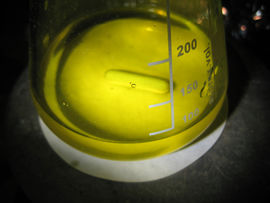Sodium chromate
 Solution of sodium chromate in water
| |
| Names | |
|---|---|
| IUPAC name
Sodium chromate
| |
| Systematic IUPAC name
Sodium chromate | |
| Other names
Chromic acid, disodium salt
Chromium disodium oxide Rachromate | |
| Properties | |
| Na2CrO4 | |
| Molar mass | 161.97 g/mol |
| Appearance | Yellow hygroscopic solid |
| Odor | Odorless |
| Density | 2.698 g/cm3 |
| Melting point | anhydrous 792 °C (1,458 °F; 1,065 K) decahydrate 20 °C (68 °F; 293 K) |
| Boiling point | Decomposes |
| 31.8 g/100 ml (0 °C) 84.5 g/100 ml (25 °C) 126.7 g/100 ml (100 °C) | |
| Solubility | Slightly soluble in ethanol, methanol |
| Solubility in methanol | 0.344 g/100 ml (25 °C) |
| Vapor pressure | ~0 mmHg |
| Hazards | |
| Safety data sheet | Sigma-Aldrich (anhydrous) Sigma-Aldrich (tetrahydrate) |
| Flash point | Non-flammable |
| Lethal dose or concentration (LD, LC): | |
| LD50 (Median dose)
|
52 mg/kg (rat, oral) |
| Related compounds | |
| Related compounds
|
Potassium chromate |
| Except where otherwise noted, data are given for materials in their standard state (at 25 °C [77 °F], 100 kPa). | |
| Infobox references | |
Sodium chromate is the inorganic compound with the formula Na2CrO4.
Contents
Properties
Chemical
At acidic pH, sodium chromate converts to sodium dichromate:
- 2 Na2CrO4 + 2 HCl → Na2Cr2O7 + 2 NaCl + H2O
Addition of concentrated sulfuric acid yields chromium trioxide:
- Na2CrO4 + H2SO4 → CrO3 + Na2SO4 + H2O
Physical
Sodium chromate is a bright yellow hygroscopic solid, soluble in water.
Availability
Sodium chromate is sold by various chemical suppliers.
In some countries, the sale of Cr(VI) compounds is regulated.
Preparation
Can be prepared by roasting chromium(III) oxide in air in the presence of sodium carbonate:
- 2 Cr2O3 + 4 Na2CO3 + 3 O2 → 4 Na2CrO4 + 4 CO2
Sodium chromate can be produced from stainless steel from dinnerware or cooking implements, which contains a minimum of 10.5% chromium by mass. First, the entire piece of stainless steel is dissolved in conc. hydrochloric acid. The resulting solution should be dark green due to the chromium(III) ion. Sodium carbonate (not sodium hydroxide) is added to the solution to neutralize all remaining acids and precipitate a mixture of iron and chromium hydroxides, which are then filtered and washed. The washed mixture is mixed with sodium hypochlorite solution, which will oxidize the chromium(III) ions to chromate (CrO42-) ions, bringing them into solution as sodium chromate. The solution is filtered, concentrated and the sodium chromate is recrystallized from the solution, then dried in a desiccator.
Projects
- Make sodium dichromate
- Make chromic acid
- Make chromium trioxide
Handling
Safety
Sodium chromate, like all hexavalent chromium compounds, is highly toxic and carcinogenic on ingestion or inhalation. Handling it without gloves can cause dermatitis, and can also be absorbed through the skin in small amounts, usually if wet. Aqueous solutions are notorious for staining most materials.
Always wear gloves and goggles when handling it, and a dust mask or respirator when handling it as a powder to avoid inhalation of it, which could be fatal.
Storage
Sodium chromate should be kept in closed bottles, with a proper label and a hazard symbol.
Disposal
Sodium chromate can be safely reduced to the less harmful Cr(III) oxide with a reducing agent, such as ascorbic acid, or potassium/sodium sulfites/metabisulfites/tiosulfates.